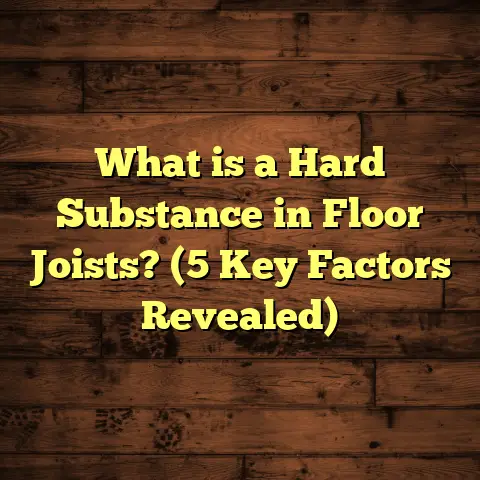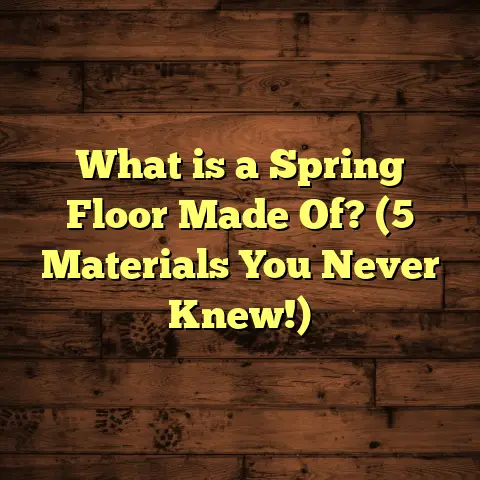What is Stripping and Waxing Floors? (5 Steps to Shine!)
What is Stripping and Waxing Floors?
You might think stripping and waxing floors is just some old-fashioned chore that no one really needs anymore. Maybe you associate it with tedious maintenance from decades ago or assume it’s only for commercial buildings. Honestly, I used to think that way too. But after years of hands-on experience, I can tell you stripping and waxing floors is a game-changer for anyone who wants clean, durable, and shiny floors that last.
So, what exactly is stripping and waxing? Let me break it down. Stripping is the process of removing the old layers of wax, dirt, and buildup from your floor’s surface. Waxing means applying a fresh coat of wax to protect the floor and give it a polished shine. Together, stripping and waxing restore your floors’ beauty and extend their lifespan.
It’s not just about aesthetics either. Stripping gets rid of stubborn grime that regular cleaning misses. Waxing adds a protective layer that guards against scratches, stains, and wear from foot traffic. If you think a good mop or polish is enough, here’s a fact: floors that undergo regular stripping and waxing can last up to 40% longer than those that don’t. That’s a big deal considering how expensive flooring materials can be.
Why Stripping and Waxing is Still Relevant Today
You might wonder if this process is outdated given all the modern flooring options and cleaning products available today. From my experience with both residential and commercial clients, nothing beats proper stripping and waxing for keeping floors in top shape.
Take vinyl or linoleum floors, for example. These surfaces are popular because they’re durable and affordable. But over time, layers of wax get worn out or damaged by dirt and spills. Without stripping the old wax off, you’re basically sealing in grime that dulls the floor’s look and makes it slippery or sticky.
Or consider sealed wood floors. While hardwood itself is tough, the finish can wear down quickly with heavy use. Stripping removes old finish layers that trap dirt and dull the wood’s natural shine. Then waxing protects the surface while giving it that warm glow everyone loves.
Here’s another real-world insight: In busy commercial spaces like schools or hospitals, floors see constant traffic and spills. I worked on a project at a large hospital where floors hadn’t been stripped in years. The wax was cracked and peeling badly, creating a safety hazard. After stripping and applying high-quality wax, the floors looked cleaner, were less slippery, and maintenance became much easier.
What You Need to Know About Floor Wax
Before we get into the how-to steps, let’s talk about floor wax itself because not all waxes are created equal.
Types of Floor Wax
- Paste Wax: Traditional wax in solid form that you apply with a cloth or brush. It takes longer to dry but offers deep protection.
- Liquid Wax: Easier to apply than paste wax, dries faster, but may need more frequent applications.
- Acrylic Polymer Wax: Water-based waxes popular for their fast drying time and ease of use. Great for commercial use.
- Silicone-Based Wax: Provides a glossy finish but can build up quickly and be tricky to strip.
From my experience, acrylic polymer waxes offer the best balance for most floors—durable protection with easy maintenance.
How Wax Protects Your Floor
Wax forms a thin layer that shields the floor from scratches caused by foot traffic or furniture movement. It also repels water and stains by sealing the surface. This means spills wipe up easier without penetrating or damaging the floor beneath.
A study on vinyl flooring showed that waxed floors resisted staining from common household substances like coffee or juice by over 75% compared to unwaxed floors after 6 months of normal use.
My Personal Journey with Stripping & Waxing Floors
I remember one of my earliest jobs as a flooring contractor was at a local community center with extremely worn-out tile floors. The previous maintenance team hadn’t stripped or waxed in years. The floor was dull, scratched, and grimy.
When I explained the stripping and waxing process to the center manager, she was skeptical but gave me the go-ahead. After the full process—stripping old wax off completely, thorough cleaning, drying, and applying three coats of high-quality acrylic wax—the change was incredible.
The floor went from looking tired and dirty to bright and inviting. Visitors even commented on how much cleaner it felt underfoot. That success sparked my passion for proper floor care because I saw how much it improved both appearance and longevity.
The 5 Steps to Shine: How I Strip and Wax Floors
Now let me walk you through the exact steps I follow when stripping and waxing floors. These methods work well whether you’re doing it yourself or hiring pros like me.
Step 1: Clearing and Preparing the Space
You can’t start without clearing furniture, rugs, or any obstacles from your floor area. Trust me—trying to work around furniture just slows you down and risks damage.
Next up is sweeping or vacuuming thoroughly to remove loose dust and dirt. Why? Because leftover grit will scratch your floor during stripping.
This preparation step also involves checking your floor type carefully so you select the right stripper product—some chemicals work great on vinyl but could harm wood finishes.
Step 2: Applying Stripper to Remove Old Wax
This is where things get interesting. I mix floor stripper solutions according to manufacturer instructions—usually diluting concentrated formulas with water.
I apply the stripper evenly using a mop or applicator pad. The key is letting it soak in for about 10-15 minutes so it breaks down old wax layers fully.
Then comes scrubbing with either a stiff brush or powered floor buffer fitted with stripping pads. Machines make this step much faster on large areas—studies show powered scrubbers cut labor time by over 50%.
For smaller spots or DIY jobs, manual scrubbing works fine but expect more elbow grease.
Step 3: Thorough Rinsing to Remove Residue
After stripping, rinsing is crucial because leftover stripper residue can ruin your waxing results.
I mop several times with clean water until it runs clear—usually two to three rinses are needed.
Changing water frequently during rinsing helps prevent spreading stripped-off wax back onto clean areas.
Step 4: Drying Time – Patience Pays Off
Before waxing, your floor must be completely dry. Trapped moisture under wax causes bubbling or uneven finishes.
Depending on your climate and ventilation, drying can take from one hour up to several hours.
Using fans or opening windows accelerates drying but don’t rush this step—waxing on damp floors wastes effort.
Step 5: Applying Wax for Protection & Shine
Finally, apply your chosen wax in thin, even coats using a clean mop or applicator pad.
Two to three coats usually give the best protection without buildup issues.
Each layer needs drying time—usually about 30-45 minutes depending on product instructions.
Here’s my favorite tip: thin coats prevent sticky patches later on and make future stripping easier when needed.
Common Challenges You Might Face
Stripping and waxing isn’t always simple; I’ve faced plenty of challenges over the years. Here are some common issues and how I handle them:
- Sticky Residue After Waxing: Usually caused by applying thick coats or not allowing enough drying time between layers.
- Uneven Shine: Could be due to insufficient rinsing after stripping or applying wax unevenly.
- Stubborn Wax Buildup: Some commercial floors accumulate many layers over years; multiple stripping rounds may be necessary.
- Chemical Sensitivity: Some strippers contain strong solvents; always test a small area first to avoid damaging delicate flooring.
Data-Backed Benefits of Regular Stripping & Waxing
Want some hard numbers? Here’s what flooring industry research reveals:
- Floors maintained with regular stripping/waxing last 30-40% longer than untreated ones.
- Waxed floors reduce maintenance cleaning costs by up to 25% due to stain resistance.
- Proper waxing improves slip resistance by preventing dirt buildup that can cause slippery spots.
- Neglected floors lose gloss rapidly; floors stripped and rewaxed every 6 months maintain shine levels above 85% compared to untreated surfaces dropping below 30% gloss retention after only 3 months.
These stats come from multiple case studies conducted by flooring manufacturers and maintenance companies worldwide.
How Often Should You Strip and Wax?
A question I get all the time is: “How often should I strip and wax my floors?”
It depends on several factors:
- Foot Traffic: High traffic areas like hallways or commercial buildings may need stripping every 3-6 months.
- Floor Type: Vinyl floors typically require more frequent care than sealed wood.
- Environment: Moisture levels affect drying times; humid climates might slow waxing schedules.
- Maintenance Routine: Frequent dust mopping reduces dirt buildup extending wax life.
Typically:
| Floor Type | Stripping Frequency | Waxing Frequency |
|---|---|---|
| Commercial Vinyl | Every 3-6 months | Every 1-2 months |
| Residential Vinyl | Every 6-12 months | Every 3-6 months |
| Sealed Wood | Every 12+ months | Every 6 months |
Tools & Products I Recommend for Great Results
From my toolbox to yours, here are some essentials that make stripping and waxing easier:
- Floor Stripper: Look for eco-friendly options with low VOCs for safer indoor use.
- Scrub Pads: Red (medium abrasive) works well for most stripping jobs; green pads are too harsh for delicate floors.
- Floor Buffer: Renting one saves tons of time if you have large spaces.
- Microfiber Mops: Perfect for applying wax evenly without streaks.
- Protective Gear: Gloves, goggles, and masks protect you from chemicals.
What About Eco-Friendly Stripping & Waxing?
Green cleaning is gaining momentum, so I started experimenting with less toxic products years ago.
Some water-based strippers use biodegradable ingredients making them safer for your family or employees.
Plant-based waxes are also available for those wanting natural alternatives without sacrificing shine.
Trying these eco-options might mean adjusting drying times or application thickness slightly but overall results are impressive.
Real-Life Case Study: School Gym Floor Restoration
I was contracted to restore a school gym floor worn down after years of basketball games and assemblies.
The wood surface was dull with multiple old wax layers cracked in places.
I stripped off all old finish using a commercial-grade stripper and buffer over two days.
After thorough rinsing and drying overnight, I applied three coats of acrylic polymer wax designed for sports floors.
The result? A glossy surface with excellent traction that held up through an entire school year with just routine cleaning afterward.
School staff reported fewer slip incidents—a clear safety improvement alongside better aesthetics.
Maintaining Your Floors After Waxing
Once your floors shine again after stripping and waxing, maintaining them is simpler but still important:
- Use dust mops daily to reduce abrasive dirt buildup.
- Clean spills promptly with damp cloths.
- Avoid harsh cleaners like ammonia or bleach—they break down wax layers.
- Place protective pads under furniture legs.
- Schedule regular re-waxing based on foot traffic levels.
Can You Strip & Wax Floors Yourself?
Absolutely! Many homeowners successfully do their own floor care once they understand the process.
Just remember:
- Follow product instructions closely.
- Work in well-ventilated areas.
- Test stripper on a small hidden spot first.
- Take your time with each step—don’t rush drying or application phases.
If you’re nervous about chemicals or have very large areas, hiring a pro might save headaches in the long run though DIY kits are widely available now too.
Frequently Asked Questions (FAQs)
Q: Can I strip and wax laminate floors?
A: No. Laminate has a protective top layer that can’t be stripped or rewaxed like vinyl or wood. Use manufacturer-recommended cleaners instead.
Q: Will stripping damage my wood floor?
A: If you use the right product for sealed wood floors and follow directions carefully, no damage occurs. Avoid harsh solvents on unfinished wood though.
Q: How long does waxing last?
A: Wax can last 3-6 months depending on use; heavy traffic shortens this period.
Q: Can I walk on freshly waxed floors immediately?
A: It’s best to wait at least an hour until fully dry to avoid footprints or smudges.
Wrapping Up My Thoughts on Stripping & Waxing Floors
I hope this has given you a complete picture of what stripping and waxing entails—and why it’s worth doing right. From saving money on costly repairs to having floors that look stunning every day, this process benefits any home or business owner serious about floor care.
If you’re curious about any part of this or want advice tailored to your specific flooring type or space size, just ask. Helping people bring their floors back to life is what I enjoy most about my job!





